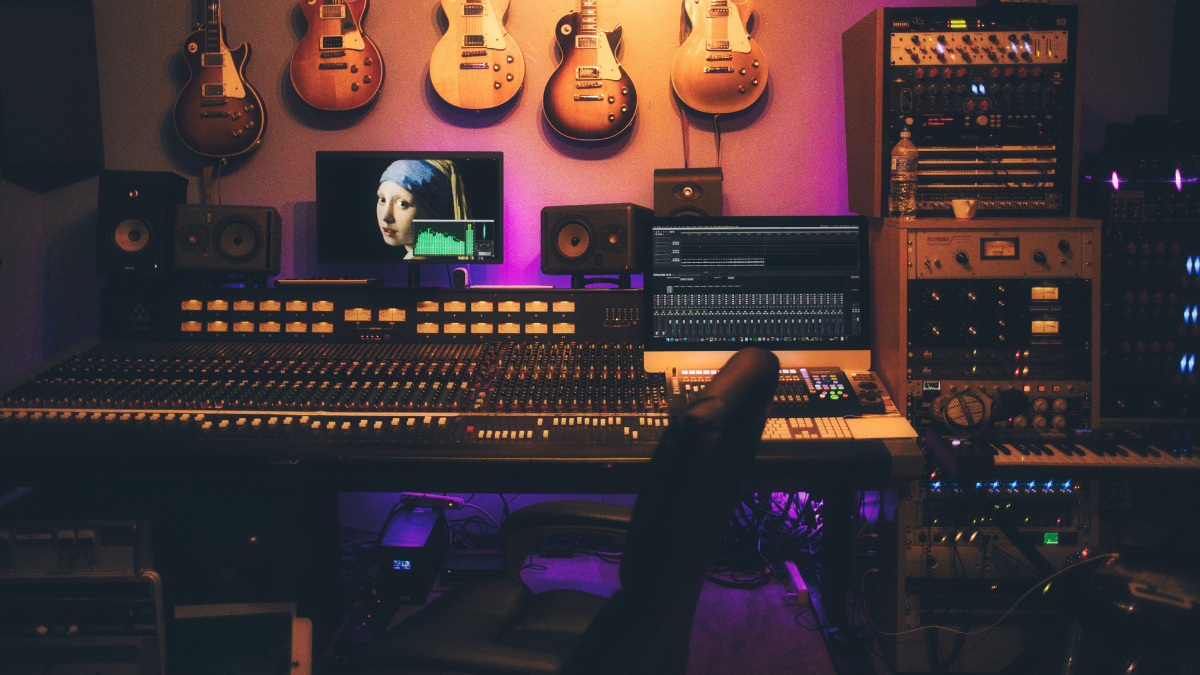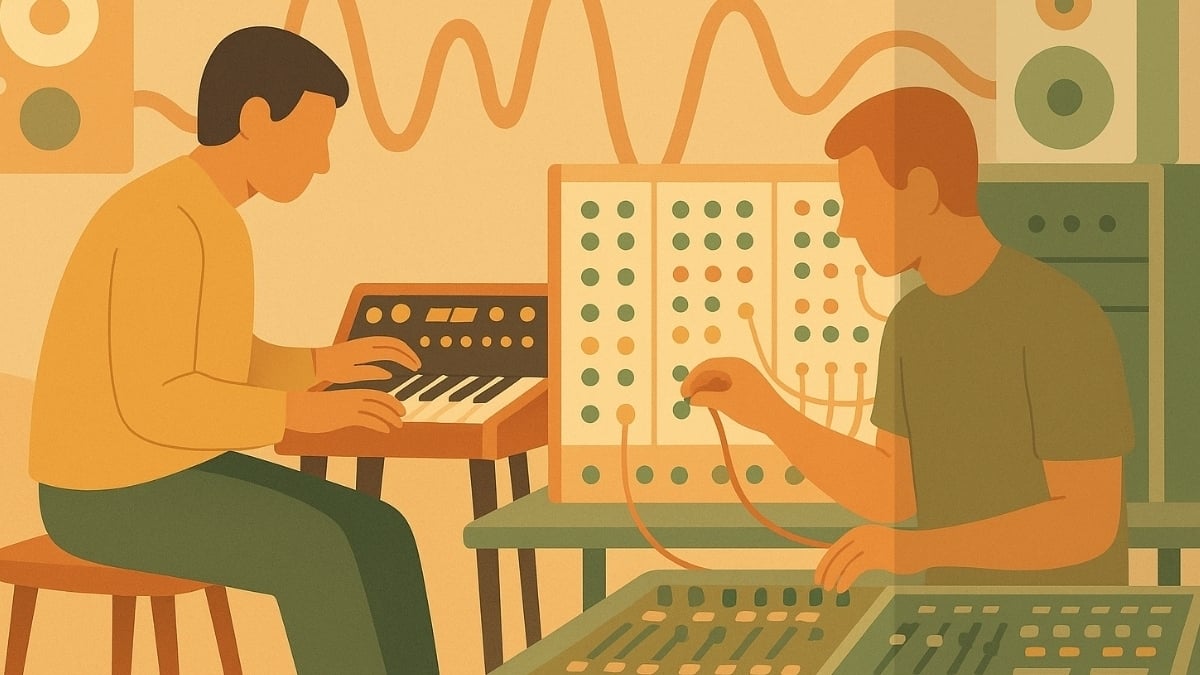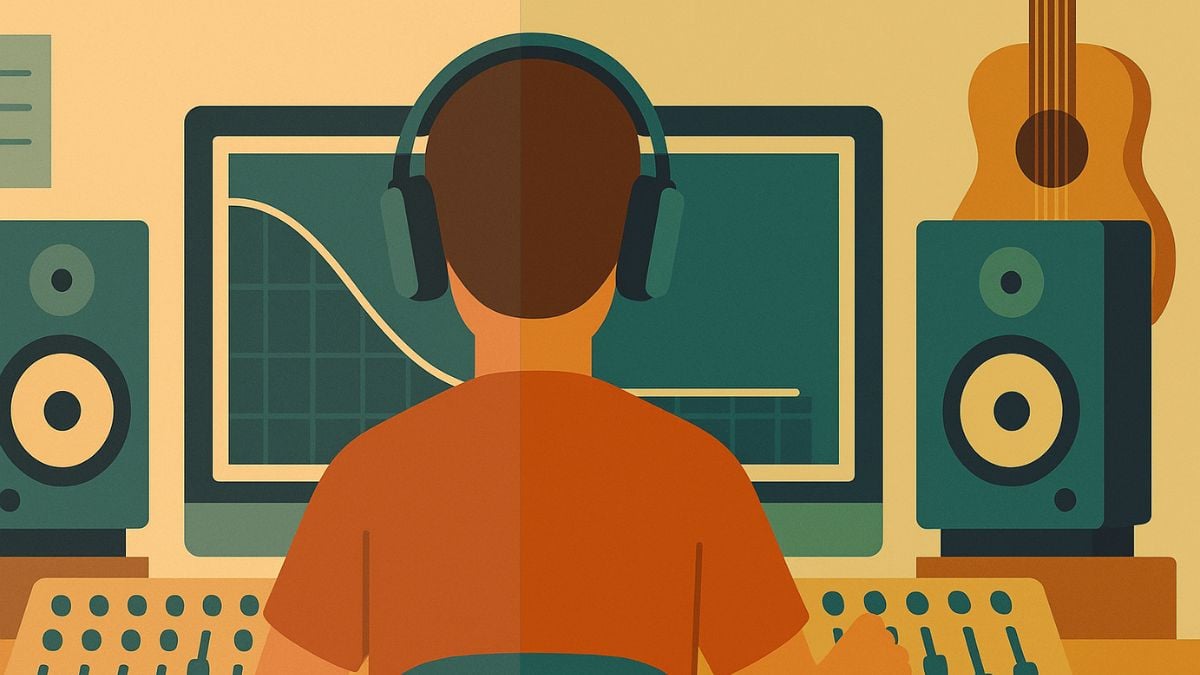What is Mastering in Music? Uncovering the Art and History of Audio Mastering

Audio mastering is often seen as a bit of a ‘dark art’ by novice producers – a process that is important but shrouded in mystery. The basic concepts of mastering are not that difficult to understand. in this article, we’ll attempt to guide you through them step by step.
By the time you finish reading this piece, you should understand what mastering is, how it differs from mixing and how the process has developed through history. We’ll also explain the different methods you can use to get your own music mastered – explaining the pros and cons of each.
What Is Mastering In Music?
Mastering is the final step in audio post-production. That means that it’s the very last process that the music goes through before it’s released commercially. Mastering can be considered the final ‘polishing up’ of a track so that it sounds as good as possible across the widest possible range of playback devices – from a phone speaker to a festival sound system.
Mastering involves the balancing of sonic elements in the track using tools such as equalization, compression, limiting, and stereo enhancement. As well as ensuring that the track sounds well-balanced across a range of playback devices, the mastering process also ensures that the track is at commercial levels of loudness and that it is optimized for the playback format it will be delivered to; CD, Vinyl, or streaming services for example. This process is completed with the intention of making the track ‘broadcast ready’.
In addition, if the track is part of a larger project, such as an EP or an album, part of the purpose of the master is to also ensure that there is a uniformity of sound from one track to the next. This process helps to guarantee that the listener has a consistent listening experience, without any volume jumps or drastic shifts of equalization.
Why Is It Important To Master Your Music?
Mastering your music is vital if you want it to compete with all of the other music out there. It is a process that helps to showcase your music in the best possible light. When your music is mastered, there won’t be a dip in volume when your track comes on the radio and it won’t sound unbalanced when played on different sound systems.
This part of the process is as important for tracks recorded in top-end studios as it is for songs produced in a bedroom; this is evidenced by the fact that every top-end music project you have listened to will have been mastered.
What’s The Difference Between Mixing And Mastering?
Mixing and mastering are both post-production processes and that can lead to some confusion between the two terms. ‘Post-production’ means that these processes take place after all recording on the track has finished.
Mixing takes place at the beginning of post-production and is the process of balancing, treating, and combining the individual musical elements that make up the track. During the mixing process, you will process audio tracks individually; drums, bass, guitars, synths, vocals – all of these elements will be manipulated separately. A mix engineer, therefore, works with a multi-track session in which independent treatment of tracks is possible.
Once the track is mixed, it will most often be bounced down to a single stereo audio file which can then be mastered. An exception to this is ‘stem mastering’. This process is less common but is certainly not rare. In the case of stem mastering, the mix engineer will bounce out several audio tracks for the mastering engineer; these will break down the track into broad constituent parts. Therefore there would normally be one stem for all the drums, one for all the guitars, one for the bass, one for the vocals, and so on. This gives the mastering engineer a greater range of options when it comes to mastering the track – but also leaves them with more work to do. Stem mastering can be useful if the track was mixed in a sub-optimal listening environment as this can lead to inaccurate EQing. The greater degree of control that stems give the mastering engineer can allow them to fix EQ problems more easily.
The History Of Mastering
The role of the mastering engineer has changed a great deal since the dawn of recorded music; as the technology employed for both recording and listening to music has changed, so have the requirements of this position. Exploring the history of mastering is also a fascinating window into why music recorded now sounds so different from that recorded in earlier eras.
The role dates back to the late 1940s when developments in recording technology meant that there was a sudden need for a new type of engineer to operate the latest equipment. The two emerging technologies that were key to these developments were vinyl and tape. Vinyl became available in 1948 and a dedicated ‘transfer engineer’ was required to transfer studio recordings from the tape they were recorded on to the vinyl ‘master’. The tape that was used to capture studio recordings had a wider dynamic range and a different frequency response to vinyl, which meant that an equalization curve had to be applied to the audio when it was transferred from one format to the other.
In the early days, the transfer engineer had a purely technical role, but over time that changed. In 1954 the Recording Industry Association of America introduced the RIAA equalization curve, which was quickly adopted as an industry-standard globally. This standardization of vinyl records and playback devices allowed for narrower grooves to be introduced on records, which meant playback times could be longer.
The problem with these new records was that if the material they were playing back was too bass-heavy, the needle could skip out of the grooves and actually damage the record itself. Engineers, therefore, had to add corrective curves during the mastering process to avoid this – without compromising the sonic quality of the music if at all possible. In order to achieve this, engineers started using tools such as compression to ensure that their masters sounded as good as possible. Of course, this meant that engineers were now making subjective decisions about the sound of the music – meaning that the role had become creative as well as technical.
New innovations in music technology over the following decades led to further changes in the role. In the late 1960s stereo was introduced, giving mastering engineers another tool to play with; they could now adjust stereo width as well as dynamics and frequency balance. In 1982 CDs were introduced and the digital age was ushered in. The industry shift to digital recording technology was gradual, but over time the signal-to-noise ratio of recorded music was vastly improved, as was the dynamic range. These developments allowed music to be mastered louder and louder than ever before.
Engineers had been competing to lay down the loudest masters since the 1950s, but digital technology accelerated this process to never before seen levels. The idea that ‘louder equals better’ comes from a perceived need to make records stand out on commercial radio. The idea is that if you are louder than the competition, your music will stand out and you will sell more copies. By the mid-1990s, this process of ever-increasing volume had become known as the ‘loudness wars’; and by the late ‘90s, records were on average 18dB louder than they had been in 1980.
This increasing loudness came at a cost; it could only be achieved through more and more extreme compression and this has repercussions on the music. The more a track is compressed, the more dynamic range is lost – and the music can end up sounding flat and lifeless as a result. The process can also lead to distortion in the master.
An interesting by-product of the streaming revolution is that it has actually led to a reversal in the loudness trend, and since 2009 the average loudness of music has started to decrease again. This is possible as platforms like Spotify have an in-built ‘loudness-normalized’ system that works to ensure that different songs playback at the same level.
This is important as modern listening habits mean that listeners might jump between different genres and different eras within one single playlist – and the streaming services want this experience to be smooth and cohesive. Nobody wants to be reaching for the volume control on their stereo every five minutes! All of this means that mastering engineers can retain more dynamic range in their masters without fear that the track won’t compete sonically with other tracks on streaming services.
3 Ways To Master Your Music
By this point, we’ve hopefully convinced you that mastering your music is a good idea. But how do you approach this process? What’s the best way to get your music mastered? There are three methods of mastering music that currently dominate the market; you can hire someone to do it for you, you can do it yourself, or you can use an AI (Artificial Intelligence) based online mastering service. Let’s explain these options one by one.
Hire A Professional
This is the traditional way of approaching mastering and is the approach taken on the vast majority of projects on which money is no object. The thinking here is that you will get the very best result if you employ an engineer who spends all day every day mastering music. It is hard to argue with this logic – someone who has dedicated their lives to the craft of mastering records is probably going to deliver a better result than you can yourself.
A mastering engineer will typically have a studio space that provides an extremely transparent listening environment. This gives them the best chance of EQing a master that will translate well over the largest number of playback devices. They will also know how far they can push the loudness of a track without sacrificing audio quality.
Importantly, a mastering engineer is also a fresh pair of ears. They can listen to your track more objectively than you can, and make decisions on what to change in order to make it sound better. Of course, ‘better’ is subjective here – and part of what you are employing a human to do is to make creative judgments on your music based on the genre, their own experience, and what it is that you tell them you are trying to achieve. An AI algorithm can’t do all this – not yet at least!
Professional mastering is a part of the music production process that is actually relatively inexpensive, and that therefore puts it in the reach of even amateur producers. You can have your track mastered in a truly world-class facility for surprisingly little; do you want your latest track to be mastered at Abbey Road? It will set you back £90. Of course, this is the top end and you can find very good mastering engineers that will work at half this price or less. If you are recording and producing music yourself, this may be an investment worth considering – especially as a good master can solve problems that may have been caused by mixing in a home studio without professional quality monitoring or acoustic treatment.
Master Your Music Yourself
In the short term, this might not be the cheaper option, as you will most likely need to invest in some dedicated mastering plugins if you want to take this part of the process seriously. However, in the long term, this could be a sensible investment – particularly if you plan on finishing a lot of music.
One downside of mastering the music yourself is that you will be performing this process in the same environment in which you mixed the track. If there are problems with your listening environment that lead to you hearing the music inaccurately, then any issues with your mix will also be present in your master. Do your best to mitigate these issues by using frequency analysis tools and a combination of headphones and monitor speakers for auditioning your music. You should also try listening to your masters on as many different speaker systems in as many different environments as you can; in your car, on your laptop speaker, on your friend’s crappy stereo, on a Bluetooth speaker in your kitchen. Your aim is to create a master that sounds great in all of these scenarios; this will give your music the best chance of sounding good once it’s out there in the world, with people consuming it in all manner of different ways in all kinds of different locations.
The second major downside of mastering music yourself is that you will lack objectivity. A fresh pair of ears can be invaluable at the mastering stage as someone hearing your music for the first time can spot flaws that you may not have noticed yourself. To try and mitigate this, the best thing you can do is to wait a few days between mixing and mastering your track – at least this way you should be more objective than you would be if you rolled straight from one part of the process into the next.
There are numerous software companies that have developed bespoke mastering plugins that can help you raise the level of a DIY master. The market leader for mastering plugins is probably iZotope’s Ozone 9. It is particularly useful for beginners as it uses AI to analyze your music and then offers you suggestions for mastering settings. These settings are generally a very useful starting point, although we would normally suggest tweaking them in order to get the best sound.The nice thing about Ozone is that it also help you learn the process of mastering – it contains modules for EQ, compression, limiting, maximisation etc. all inside one plug-in.
By looking at how Ozone handles the mastering process, you can learn how to do it yourself. As you grow more confident, you will probably want to start putting your own mastering chain together and may well want to explore plugins from many of the other software companies doing good work in this area; FabFilter, Brainworx and Sonnox are all well worth checking out in this regard.
Online Mastering Services
A relatively new way to get your music mastered is through an AI-driven online service such as LANDR. This is undoubtedly the cheapest way to go – in the short term at least – as you can get masters of your tracks for less than $10. You can even pay a monthly subscription fee that allows you to create unlimited masters.
The primary benefit of this form of mastering is therefore financial. However, the service provided is certainly useable, and early on in your career, it could be a good fit. At the very least, AI mastering will ensure that your music is at the correct loudness levels for a commercial release, and should go some way towards compensating for any EQ issues that are present in your mix. LANDR also has an option that allows you to tweak individual components in the mastering chain – if you pay for a premium service.
At this point, AI mastering services can’t compete with trained professionals – but they are improving all the time and they certainly have their place in the mastering ecosystem.
Final Words
We hope that you now have a good overview of the subject of mastering. We’ve explained why it’s important, how it developed and how you can get your own music mastered. The next step is for you to give this process a try – see how much of a difference it can make to your music! We do really recommend that you try mastering your own music at some point. Even if you end up using professionals for your commercial releases, it is always helpful to be able to create rough masters yourself – and the best way to understand this fascinating discipline is by diving in and trying it out for yourself.



Comments:
Login to comment on this post